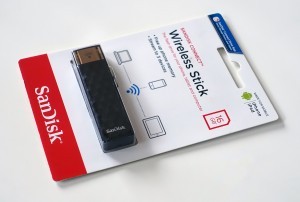 This experiment tests the speed of Sandisk Connect Wireless Stick. This is a wireless USB drive that we can use with our computer as normal USB stick because it has full-sized USB 2.0 connector. We can also use it in WiFi mode, allowing wireless access from our computers, phones or tablets.
This experiment tests the speed of Sandisk Connect Wireless Stick. This is a wireless USB drive that we can use with our computer as normal USB stick because it has full-sized USB 2.0 connector. We can also use it in WiFi mode, allowing wireless access from our computers, phones or tablets.
For this test, I use a Mac mini with built-in USB 3.0 ports. Sandisk Connect Wireless Stick is accessed through both its USB connector and via WiFi connection. I prepared three sets of data to be written to, and read from the USB stick:
- Data A is 1 large file. The size is 4.25 GB.
- Data B is a set of 12 medium files. The total size is 5.81 GB.
- Data C is a set of 45,976 small files. The total size is 5.47 GB.
Testing process for the file transfer via USB connection is simple. To measure WRITE speed, I copied each set of data into the USB and timed the process. To measure READ speed, I copied back those sets of data back into my computer and timed the process. To perform the file transfers, I use a tool named ChronoSync version 4.8.4. This is a backup app for Mac, but I have good experience using it as file copier because it performs generally faster than using the standard Finder.
Testing process for the file transfer via WiFi is more difficult. Sandisk only provides browser interface to transfer file, therefore I can not use my ChronoSync tool to time the transfer. Instead, I actually need to use a stopwatch and time the process, hoping I will not miss the moment of completion while I work on other things. The browser interface only allows us to copy files into the wireless stick, not the other way around, so I can only measure WRITE operation. I managed to do data A and B, but I just didn’t have the patience to do data C, sorry.
For comparison, I put the speed data of my fastest USB drive: Sandisk Cruzer Extreme 32 GB with USB 3.0.
| Operation | Data | Sandisk Connect via USB |
Sandisk Connect via WiFi |
Sandisk Cruzer Extreme |
| WRITE | A | 11 mins 6 secs avg speed 6.53 MB/s |
1 hour 28 mins 10 secs avg speed 0.82 MB/s |
45 secs avg speed 96.71 MB/s |
| WRITE | B | 12 mins 23 secs avg speed 8.01 MB/s |
1 hour 29 mins 38 secs avg speed 1.11 MB/s |
1 min 1 sec avg speed 97.52 MB/s |
| WRITE | C | 47 mins 35 secs avg speed 1.96 MB/s |
not tested | 5 mins 37 secs avg speed 16.62 MB/s |
| READ | A | 5 mins 26 secs avg speed 13.35 MB/s |
not testable | 37 secs avg speed 117.62 MB/s |
| READ | B | 7 mins 24 avg speed 13.40 MB/s |
not testable | 50 secs avg speed 118.98 MB/s |
| READ | C | 30 mins 20 secs avg speed 3.08 MB/s |
not testable | 3 mins 14 secs avg speed 28.87 MB/s |
When I purchased this wireless stick, I did read that the USB connection still uses the old USB 2.0. I guess I am already spoiled with the speed of USB 3.1 and forgot how slow it was with USB 2.0. As you can see, copying large data via USB 2.0 takes a lot of time. File transfer using the stick’s built-in WiFi feature takes even more time. I guess the product was not really designed for mass file transfer. Perhaps the variants with higher storage capacity are bundled with better speed.
To be fair, Sandisk Connect Wireless Stick does decent job as a media stick. We can easily store photos and short videos inside the storage, and access the media using the app in our smartphones and tablets. This product delivers such function well, provided we are patient enough to wait for the file transfer to complete.

Leave A Comment